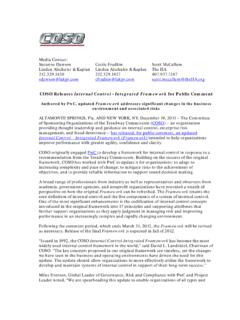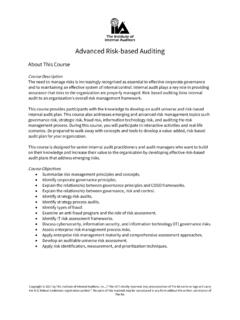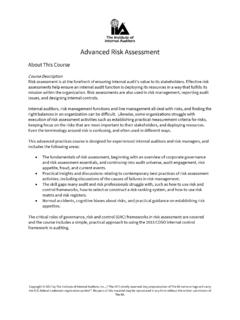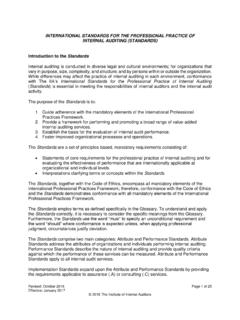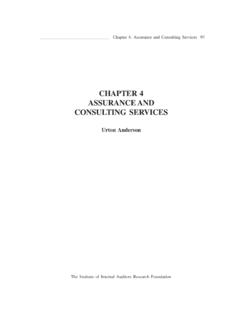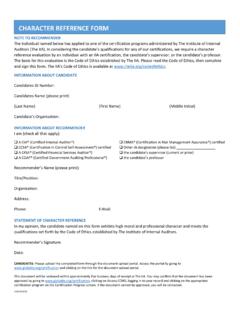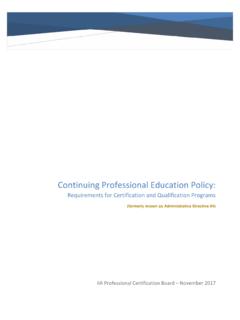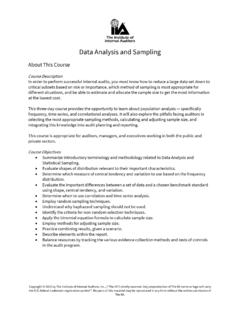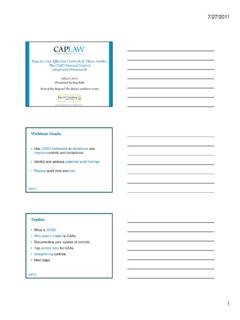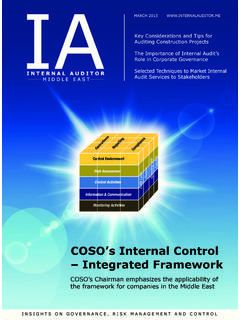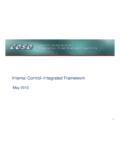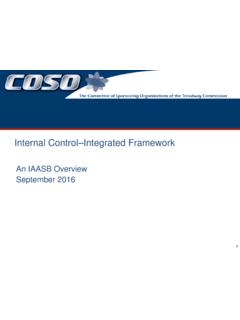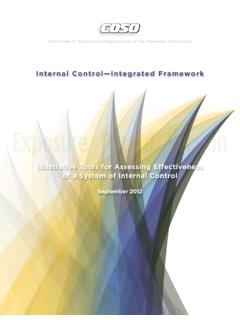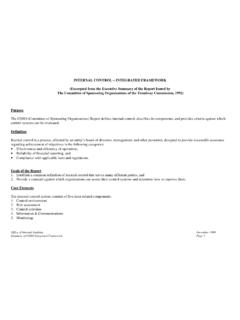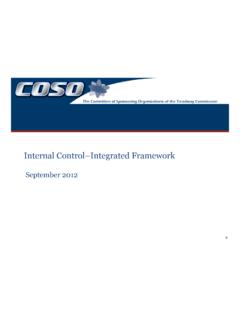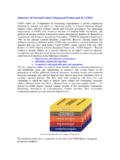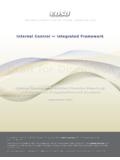Transcription of Internal Control — Integrated Framework
1 Internal Control Integrated FrameworkExecutive SummaryCommittee of Sponsoring Organizations of the Treadway CommissionMay 2013 ISBN 978-1-93735-239-4 2013 All Rights Reserved. No part of this publication may be reproduced, redistributed, transmitted or displayed in any form or by any means without written permission. For information regarding licensing and reprint permissions please contact the American Institute of Certified Public Accountants, licensing and permissions agent for COSO copyrighted materials. Direct all inquiries to or to AICPA, Attn: Manager, Rights and Permissions, 220 Leigh Farm Rd., Durham, NC 27707.
2 Telephone inquiries may be directed to Control Integrated FrameworkExecutive SummaryCommittee of Sponsoring Organizations of the Treadway CommissionCommittee of Sponsoring Organizations of the Treadway CommissionMay 2013 This project was commissioned by COSO, which is dedicated to providing thought lead-ership through the development of comprehensive frameworks and guidance on Internal Control , enterprise risk management, and fraud deterrence designed to improve organi-zational performance and oversight and to reduce the extent of fraud in organizations. COSO is a private sector initiative, jointly sponsored and funded by: American Accounting Association (AAA) American Institute of Certified Public Accountants (AICPA) Financial Executives International (FEI) Institute of Management Accountants (IMA) The Institute of Internal Auditors (IIA)Committee of Sponsoring Organizations of the Treadway Commission Board Members David L.
3 LandsittelCOSO ChairMark S. BeasleyDouglas F. PrawittAmerican Accounting AssociationRichard F. ChambersThe Institute of Internal AuditorsCharles E. LandesAmerican Institute of Certified Public AccountantsMarie N. HolleinFinancial Executives InternationalSandra RichtermeyerJeffrey C. ThomsonInstitute of Management AccountantsPwC AuthorPrincipal Contributors Miles EversonEngagement LeaderNew York, USAS tephen E. Soske Project Lead Partner Boston, USA Frank J. Martens Project Lead Director Vancouver, Canada Cara M. Beston Partner San Jose, USA Charles E. Harris Partner Florham Park, USA J. Aaron Garcia Director San Diego, USA Catherine I.
4 Jourdan Director Paris, France Jay A. Posklensky DirectorFlorham Park, USAS allie Jo Perraglia Manager New York, USAA dvisory CouncilSponsoring Organizations RepresentativesAudrey A. Gramling Bellarmine UniversityFr. Raymond J. Treece Endowed ChairSteven E. JamesonCommunity Trust BankExecutive Vice President and Chief Internal Audit & Risk OfficerJ. Stephen McNallyCampbell Soup CompanyFinance Director/ControllerRay PurcellPfizerDirector of Financial ControlsWilliam D. Schneider Director of AccountingMembers at LargeJennifer BurnsDeloitte PartnerJames DeLoachProtiviti Managing DirectorTrent GazzawayGrant Thornton PartnerCees Klumper The Global Fund to Fight AIDS, Tuberculosis and Malaria Chief Risk OfficerThomas MontminyPwCPartnerAlan PaulusErnst & Young LLP PartnerThomas Ray Baruch College Dr.
5 Larry E. RittenbergUniversity of Wisconsin Emeritus Professor of Accounting Chair Emeritus COSOS haron ToddKPMG PartnerKenneth L. Vander WalISACA International President 2011 2012 Regulatory Observers and Other ObserversJames Dalkin Government Accountability OfficeDirector in the Financial Management and Assurance TeamHarrison E. Greene Deposit Insurance CorporationAssistant Chief AccountantChristian PeoSecurities and Exchange CommissionProfessional Accounting Fellow (Through June 2012)Amy SteeleSecurities and Exchange CommissionAssociate Chief Accountant (Commencing July 2012)Vincent TophoffInternational Federation of AccountantsSenior Technical ManagerKeith WilsonPublic Company Accounting Oversight BoardDeputy Chief AuditorForewordIn 1992 the Committee of Sponsoring Organizations of the Treadway Commission (COSO) released its Internal Control Integrated Framework (the original Framework ).
6 The original Framework has gained broad acceptance and is widely used around the world. It is recognized as a leading Framework for designing, implementing, and con-ducting Internal Control and assessing the effectiveness of Internal Control . In the twenty years since the inception of the original Framework , business and operat-ing environments have changed dramatically, becoming increasingly complex, techno-logically driven, and global. At the same time, stakeholders are more engaged, seeking greater transparency and accountability for the integrity of systems of Internal Control that support business decisions and governance of the is pleased to present the updated Internal Control Integrated Framework ( Framework ).
7 COSO believes the Framework will enable organizations to effectively and efficiently develop and maintain systems of Internal Control that can enhance the likelihood of achieving the entity s objectives and adapt to changes in the business and operating environments. The experienced reader will find much that is familiar in the Framework , which builds on what has proven useful in the original version. It retains the core definition of Internal Control and the five components of Internal Control . The requirement to consider the five components to assess the effectiveness of a system of Internal Control remains unchanged fundamentally.
8 Also, the Framework continues to emphasize the importance of management judgment in designing, implementing, and conducting Internal Control , and in assessing the effectiveness of a system of Internal the same time, the Framework includes enhancements and clarifications that are intended to ease use and application. One of the more significant enhancements is the formalization of fundamental concepts that were introduced in the original Framework . In the updated Framework , these concepts are now principles, which are associated with the five components, and which provide clarity for the user in designing and implement-ing systems of Internal Control and for understanding requirements for effective Internal Control .
9 The Framework has been enhanced by expanding the financial reporting category of objectives to include other important forms of reporting, such as non-financial and Internal reporting. Also, the Framework reflects considerations of many changes in the business and operating environments over the past several decades, including: Expectations for governance oversight Globalization of markets and operations Changes and greater complexities of business Demands and complexities in laws, rules, regulations, and standards Expectations for competencies and accountabilities Use of, and reliance on, evolving technologies Expectations relating to preventing and detecting fraud Internal Control Integrated Framework March 2013iInternal Control Integrated FrameworkThis Executive Summary, provides a high-level overview intended for the board of directors, chief executive officer, and other senior management.
10 The Framework and Appendices publication sets out the Framework , defining Internal Control , describing requirements for effective Internal Control including components and relevant principles, and providing direction for all levels of management to use in designing, implementing, and conducting Internal Control and in assessing its effectiveness. Appendices within the Framework and Appendices provide additional reference, but are not considered a part of the Framework . The Illustrative Tools for Assessing Effectiveness of a System of Internal Control , provides templates and scenarios that may be useful in applying the Framework .
